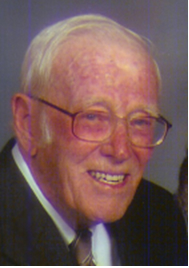In Memory of Ernest H. Horton, Sr.
1922–2004
 Ernest H. Horton,
Sr., a longtime member of GCSSEPM, passed away on June 4, 2005. He was
born in Long Island, New York in 1922. Ernie entered college at Colgate
University in Hamilton, New York in 1941. The start of World War II interrupted
Ernie's education, and he enlisted in the Army in 1942. Ernie served with
the U.S. Army Air Force 322nd Fighter Control Squadron as a scout and
air strike coordinator. Ernie served in China at one point during the
war, and when he found spare time, he would often search a nearby Chinese
library for reading material. During one such excursion, Ernie found two
geology books written in English. This event sparked a keen interest in
geology that persisted throughout his career.
Ernest H. Horton,
Sr., a longtime member of GCSSEPM, passed away on June 4, 2005. He was
born in Long Island, New York in 1922. Ernie entered college at Colgate
University in Hamilton, New York in 1941. The start of World War II interrupted
Ernie's education, and he enlisted in the Army in 1942. Ernie served with
the U.S. Army Air Force 322nd Fighter Control Squadron as a scout and
air strike coordinator. Ernie served in China at one point during the
war, and when he found spare time, he would often search a nearby Chinese
library for reading material. During one such excursion, Ernie found two
geology books written in English. This event sparked a keen interest in
geology that persisted throughout his career.
Ernie was also a survivor of a remarkable event during WWII. On November 26, 1943, one thousand, one hundred and thirty-eight men perished when a British troopship, the HMT Rohna, was attacked from the air and destroyed in the Mediterranean Sea off the coast of Algeria. Two important but virtually unknown historical events occurred at that time. It was the first successful "hit" of a merchant vessel at-sea carrying U.S. troops by a German remote-controlled, rocket-boosted bomb, thus giving birth to the "Missile Age", and it resulted in the greatest loss of U.S. troops (1015) at sea in U.S. military history. Combined with the loss of ship's crew and officers, and Red Cross workers, more lives were lost than on the USS Arizona at Pearl Harbor.
After the war, Ernie returned to Colgate, and in 1946, he married his longtime sweetheart Jane Hamlin. He graduated with honors from Colgate University with a BA in Geology in 1948. Ernie went on to graduate school at Rutgers University and graduated with honors with an MS in Micropaleontology in 1950.
Ernie began his professional career as a Geologist in 1950 with Amerada Petroleum Corporation in Houston. During his early career, he specialized in micropaleontology of the Gulf Coast region. In 1953, Ernie was transferred to San Antonio, where he was encouraged to expand his geologic interest into a broader field encompassing all aspects of exploration. Ernie spent 28 years working for Amerada Hess in Houston, Lafayette, and San Antonio. In 1977, Ernie retired from Amerada and accepted a position as Chief Geologist for Tesoro Petroleum in San Antonio. Throughout his tenure at Tesoro, Ernie focused the exploration efforts on the Wilcox trend of South Texas. Ernie retired from Tesoro in 1986 and accepted a consulting position with Suburban Propane Company in San Antonio. In 1988, Ernie became an independent consultant and formed a new company, Paleo-Ecosystems, where he returned to his roots as a Micropaleontologist. He stayed active as a consultant and enjoyed peering at well samples under the microscope looking for "bugs".
In addition to GCSSEPM, Ernie was a member of SEPM, AAPG, South Texas Geological Society, and Corpus Christi Geological Society. He unselfishly contributed much time and effort to professional organizations over the years, and served as chairman and member of numerous committees during GCAGS-GCSSEPM and AAPG-SEPM conventions.
Ernie also supported the community by working as a volunteer at a local hospital for many years. Ernie sang in his church choir and had been a member of the choir for more than 20 years. He continued to work as a consultant and was considered one of the top experts in Gulf Coast micropaleontology. Ernie will be dearly missed by all of us who have had the pleasure and honor of working and associating with him during his career.
Raymond Jones
